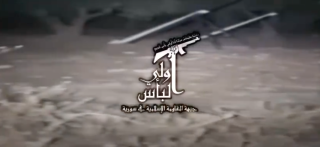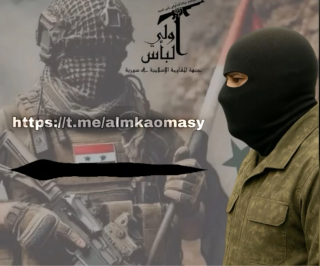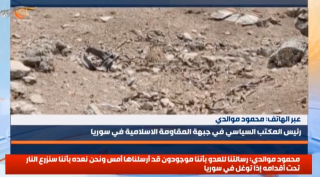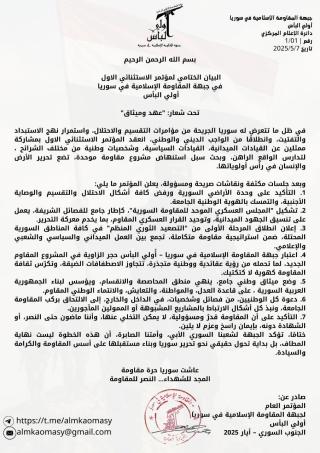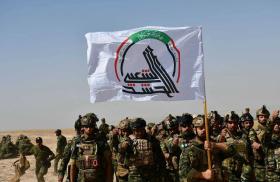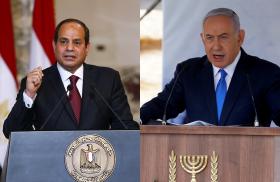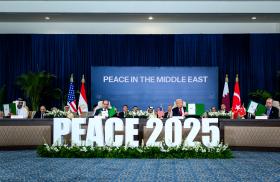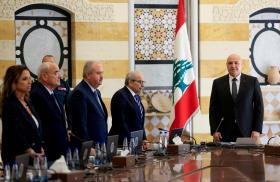

The group's name has been making the rounds for months, but videos and other actual evidence of its claimed attacks against Israel are only now beginning to emerge.
On June 3, the Iran-aligned militia the Islamic Resistance Front in Syria-Possessors of Might (Uli al-Baas, or UAB) claimed responsibility for what appears to be its first verified attack on Israel. Militia Spotlight reported on the emergence of the UAB brand in a two-part analysis in March, but at that point it was difficult to identify actual attacks and other real-world activity that might be connected to the Syrian group’s online presence. This may now be changing.
Attack Claim
The June 3 claim included a short, low-quality video clip of what appeared to be two rocket launchers, but it did not show any launches (Figure 1). At the same time, the Israel Defense Forces reported that two rockets had been fired from Syria toward the Golan Heights, the first cross-border strike since the Assad regime's collapse in December. Although UAB had previously claimed attacks on Israeli forces inside Syria, this was the first incident with some visual evidence supporting its involvement.
The next day, UAB military spokesman Abu al-Qasem read a statement that was circulated on social media claiming responsibility for the attack and pledging further operations: “What happened was merely a test to assess the strengths and weaknesses on which the enemy builds its military system. The initial results are in our hands, and they will serve as the basis for upcoming stages of calculated escalation” (Figure 2).
Details on UAB Membership
The same day that Qasem's statement was released, UAB Political Bureau chief Dr. Mahmoud Mawaldi offered a profile of the group during a phone interview with the Hezbollah-affiliated Lebanese television network al-Mayadeen: “Uli al-Baas is a revolutionary and liberationist organization and a resistance movement that adopts smart resistance tactics...We are a comprehensive organization, with both a political wing and a military wing. We held our founding conference about a month ago in Damascus" (Figure 3).
According to UAB, this "First General Extraordinary Conference" began on May 5 and spanned two days. The group’s Telegram channel noted that Mawaldi and several other figures spoke at the event, including:
- Dr. Abbas al-Ahmad, UAB's head of central media, who delivered the opening statement
- Batul Badr, head of the group's Women’s Affairs Department
- Dr. Jubran Salim, head of the group's Economic and Advisory Department
- Malak al-Dhahir, head of the Expatriates Unit for the Entire Russian Federation
- Ali al-Ashqar, UAB's head of organizational affairs
- Abu Shuaib, commander of Saraya al-Areen (Companies of the Den)
- Brig. Gen. Mundhir W., general commander of al-Muqawama al-Shabiya al-Suriya (Syrian Popular Resistance)
The latter two speakers purportedly called on factions and commanders to support “the formation of a unified national military umbrella to confront the occupation, its proxies, and the partition project imposed on Syria.”
According to an-Nahar newspaper, other factions have already joined UAB. Sources close to the group described a new "Unified Military Council for the Syrian Resistance" composed of UAB and other armed collectives such as Dir al-Sahel (Shield of the Coast), which reportedly defected from Miqdad Fattiha.
Future Plans
The closing statement of the conference emphasized seven points (Figure 4):
- Reaffirmation of Syria’s territorial unity.
- Formation of the “Unified Military Council.”
- Launch of the first phase of “organized revolutionary escalation."
- Recognition of the "Islamic Resistance Front in Syria-Uli al-Baas" as the cornerstone of the new resistance project.
- Adoption of a unifying national charter.
- A call to all "patriots" inside and outside Syria to join the united "resistance" movement.
- Affirmation that resistance is a duty, and destiny that cannot be abandoned.
On May 12, UAB leader Abu Jihad Ridha (aka Ridha Hussein) released his first recorded voice message to the Lebanese newspaper an-Nahar, declaring: “The battle has not yet begun, and the truth can only be won by force and will.” The message appears to have been electronically manipulated, making voice comparison unreliable. Yet the intonation closely resembles Qasem's voice, suggesting that he and Ridha may be the same person.
Analysis
UAB is trying to portray itself as a structured, ideologically driven force, blending militant rhetoric with political messaging and claims of formal organization. The group has clearly evolved since its chaotic early statements, honing an image of a coordinated movement with defined leadership. Questions remain about the credibility of its leadership and the reality of its operations. Still, if the current security vacuum endures in key parts of Syria, the group may develop into a more serious actor. Its trajectory will largely depend on whether Iran's Islamic Revolutionary Guard Corps-Qods Force and allied Iraqi militias can sustain their support to the group. As Militia Spotlight previously noted, IRGC-linked Farsi-language channels on Telegram have actively backed UAB’s launch since late January, suggesting strong sponsorship from the Iranian regime's most prolific builder of foreign proxy forces.
